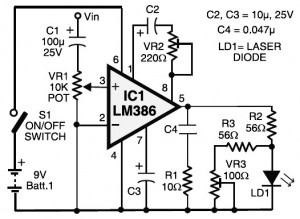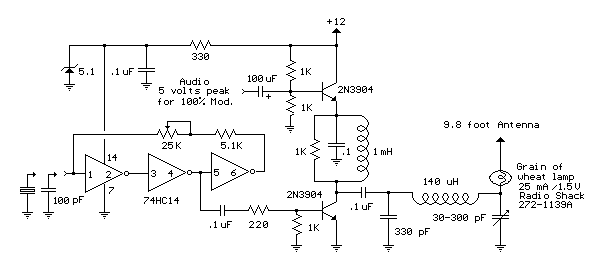
USB Mono FM Transmitter

This compact FM transmitter has a range of approximately 50 meters and is designed for connection to a USB port. By utilizing multiple mini-transmitters, a comprehensive and engaging radio program can be created. The power supply through the USB port ensures high frequency stability. Alternatively, the transmitter can also be powered using a battery with a voltage range of 5 to 12 volts. The USB FM transmitter prototype does not require drilling the transmitter PCB. All components will be soldered to the board with their leads bent appropriately. The transistor features a flat side, while the LED has one lead longer than the other; the longer lead is the anode (A) and the shorter lead is the cathode (K). The audio cable (minijack) must be modified from a stereo cable to a mono configuration by soldering the white and red wires together and leaving the yellow wire (ground) aside. Frequency adjustment can be performed by gently turning the variable capacitor with a screwdriver or a thin, rigid piece of cardboard.
This FM transmitter circuit is designed to operate efficiently within a specified range, making it suitable for various applications such as personal broadcasting or educational projects. The core components of the circuit include a USB interface for power supply, a transistor for amplification, and an LED for visual indication of operation. The transmitter's ability to connect directly to a USB port not only simplifies the power supply requirements but also enhances portability and ease of use.
The design approach eliminates the need for drilling the PCB, which simplifies the assembly process. Components are soldered directly to the board, ensuring a compact and robust design. The careful arrangement of components, including the transistor and LED, facilitates effective signal transmission while maintaining a streamlined layout.
The audio input configuration is critical for ensuring proper signal transmission. By modifying the audio cable from stereo to mono, the circuit can effectively combine the left and right audio channels, enhancing the overall audio output quality. The inclusion of a variable capacitor allows for fine-tuning of the transmission frequency, which is essential for avoiding interference with other radio signals and optimizing performance.
In summary, this FM transmitter design provides a user-friendly and efficient solution for short-range audio broadcasting. Its compact form factor, straightforward assembly process, and adjustable frequency settings make it an ideal choice for hobbyists and educators interested in exploring the fundamentals of radio transmission.This small FM transmitter with a range of about 50 meters designed for connection to the USB port. With lots of mini-transmitters then you have a comprehensive, action-packed radio program. Due to the power supply via the USB port of a high frequency stability is achieved. Alternatively, the receiver, a battery 5 to 12 volts to operate. USB FM Transmitt er Prototype It is not necessary to drill the transmitter PCB. All components will be soldered to the plate with their legs folded, like this: The transistor has a flat side, the LED a foot longer than the other is the anode (A), the other is the cathode (K). The audio cable (minijack) must be transformed from a stereo cable into a cable. Soldering together the white and red cables, leaving aside the yellow cable (mass). The frequency setting will be turning the variable capacitor gently with a screwdriver or thin cardboard but rigid.
🔗 External reference
This FM transmitter circuit is designed to operate efficiently within a specified range, making it suitable for various applications such as personal broadcasting or educational projects. The core components of the circuit include a USB interface for power supply, a transistor for amplification, and an LED for visual indication of operation. The transmitter's ability to connect directly to a USB port not only simplifies the power supply requirements but also enhances portability and ease of use.
The design approach eliminates the need for drilling the PCB, which simplifies the assembly process. Components are soldered directly to the board, ensuring a compact and robust design. The careful arrangement of components, including the transistor and LED, facilitates effective signal transmission while maintaining a streamlined layout.
The audio input configuration is critical for ensuring proper signal transmission. By modifying the audio cable from stereo to mono, the circuit can effectively combine the left and right audio channels, enhancing the overall audio output quality. The inclusion of a variable capacitor allows for fine-tuning of the transmission frequency, which is essential for avoiding interference with other radio signals and optimizing performance.
In summary, this FM transmitter design provides a user-friendly and efficient solution for short-range audio broadcasting. Its compact form factor, straightforward assembly process, and adjustable frequency settings make it an ideal choice for hobbyists and educators interested in exploring the fundamentals of radio transmission.This small FM transmitter with a range of about 50 meters designed for connection to the USB port. With lots of mini-transmitters then you have a comprehensive, action-packed radio program. Due to the power supply via the USB port of a high frequency stability is achieved. Alternatively, the receiver, a battery 5 to 12 volts to operate. USB FM Transmitt er Prototype It is not necessary to drill the transmitter PCB. All components will be soldered to the plate with their legs folded, like this: The transistor has a flat side, the LED a foot longer than the other is the anode (A), the other is the cathode (K). The audio cable (minijack) must be transformed from a stereo cable into a cable. Soldering together the white and red cables, leaving aside the yellow cable (mass). The frequency setting will be turning the variable capacitor gently with a screwdriver or thin cardboard but rigid.
🔗 External reference





